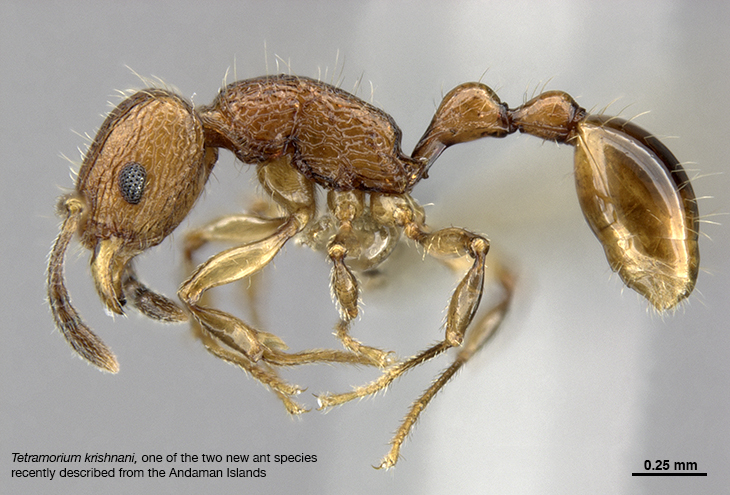Ants are some of the smallest animals on earth but have a huge impact on the environment. Despite their important roles in the ecosystem, ant biodiversity in many tropical areas remains poorly documented and India is no exception.
NCBS student and collaborators recently described two new species of ants from the Andaman Islands. They named the tiny, leaf-litter inhabiting ants as Tetramorium krishnani and Tetramorium jarawa. The former was named in honor of late Prof K S Krishnan of NCBS, and the latter after the Jarawas, an indigenous people known to inhabit the Andaman Islands for at least several thousand years. Both new species are believed to be endemic to the Andaman Islands (i.e. they are not found anywhere else). In an extended paper, the authors also summarized the diversity of the hyperdiverse ant genus Tetramorium in India and provided illustrated identification keys and other new taxonomic information.
In the Amazonian forests, it is estimated that the biomass of ants alone exceeds that of all land vertebrates combined (including birds, mammals, amphibians, and reptiles), by as much as four times! While a well-read person is likely aware of interesting facts about ants such as their eusocial lifestyle and ability to farm, we often fail to acknowledge and celebrate their remarkable diversity. Ants are one of the most ubiquitous and species-rich animal groups on earth, present on all continents except Antarctica. Globally, over 13,000 species of ants are known so far and hundreds more await discovery and/or formal species description. This number constitutes only a tiny fraction (<2%) of the known global insect fauna, but in terms of biomass ants are estimated to represent at least one-third of the global insect fauna. Given this massive biomass and strong associations with other animals and plants, ants have tremendous impacts on their environment and are aptly described as “ecosystem engineers”.
Over 800 ant species are known to occur in India. However, this number is likely to be a gross underestimate considering the variety of habitats and ecosystems and the relative lack of exploration in many parts of the country. This was one of the factors that convinced Gaurav Agavekar, a student in the WCS-NCBS MSc program in Wildlife Biology and Conservation (2014-16), to conduct his master’s dissertation research on ants. Gaurav wanted to understand the biotic and abiotic factors that are important in shaping ant community structure. Hence, he chose to focus on ants on the Andaman Islands because such an analysis is easier to conduct on an island with two habitats that differ in a number of features such as tree canopy cover and soil type. Since the ant fauna of these islands is not well documented, another goal of his master’s thesis was to exhaustively document the ant diversity on his study island. “We have relatively poor documentation of the biodiversity in our country, compared to many developed and some developing nations; this is especially true for highly diverse taxa such as insects. While a detailed understanding of the distribution and abundance of biodiversity is critical to conserve as well as better understand the ecological and evolutionary processes shaping it, we lack good baseline data for many groups of animals that occur in India”, explained Gaurav Agavekar. With these goals in mind, he set off for Havelock Island in the Andaman Islands archipelago in late 2015 and combed through its forests for 3 months to collect ants inhabiting the leaf-litter. He was advised by Dr Deepa Agashe (NCBS) and Dr Evan Economo (OIST, Japan) for his thesis.
During his surveys, Gaurav found 50 ant species on this rather small island (~110 km2), several of which were recorded for the first time in the Andaman Islands. Further, around a half dozen species are likely to be new to science. Gaurav teamed up with Dr Francisco Hita Garcia, an ant biologist and systematicist in the Economo lab at OIST, to describe two new species of the genus Tetramorium found in the surveys. Tetramorium is a highly diverse ant genus with more than 600 species described globally. The genus is thought to have originated in the African tropics, which host a major fraction (over one-third) of its global diversity. It is a taxonomically difficult genus because many species look very similar to each other and correct species identification requires considerable taxonomic skill. To make species identifications easier and summarize existing taxonomic knowledge of the Indian Tetramorium fauna, the researchers also reviewed Tetramorium diversity in India.
|
3D ants: adding a third dimension to species documentation |
Both new species were found in the evergreen forests on Havelock Island. While Tetramorium krishnani was relatively common, T. jarawa was collected only once during the survey. Much important information on aspects of Tetramorium biology such as diet, colony structure, or behaviour is missing. However, the morphology of the head and the small eyes of T. jarawa resemble another Tetramorium species in Africa. The African species eats termites and lives a cryptic lifestyle in close proximity to termite mounds. The authors speculate that T. jarawa might also have a similar lifestyle and diet, which would also explain its rarity in collections. Further, since tropical island archipelagos worldwide are known to harbor a considerable number of endemic ant species owing to their geographic isolation, the authors speculate that the new species are likely to be endemic to the Andaman Islands.
The current paper serves as an update to the taxonomy of Indian Tetramorium fauna. It also highlights the fact that much ant diversity in the Andaman Islands remains unexplored and many more endemic species are likely to be discovered in the future surveys. Such surveys are critical in that they provide baseline data for conservation planning of endemic and rare taxa, as well as for improving our understanding of the processes shaping biodiversity on islands










0 Comments